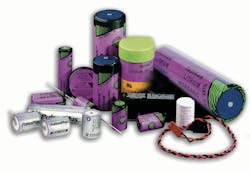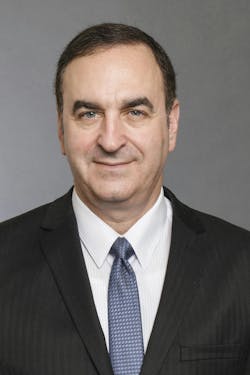A growing number of Industrial Internet of Things low-power applications demand the use of batteries that can last for decades. These demanding applications range from asset tracking to safety systems, advanced metering, tank level and flow measuring, environmental monitoring, machine to machine communications and wireless mesh networks, to name a few.
To achieve the extended battery life required by these applications, the batteries used must be highly energy efficient, drawing small amounts of average current measurable in micro-Amps with pulses in the multi-Amp range. As a result, more energy is typically consumed from self-discharge than is required to operate the device. To satisfy this increased energy demand, the use of an energy harvesting device—in combination with an industrial grade rechargeable Lithium-ion (Li-ion) battery—is needed to store the harvested energy.
It should be noted here that consumer grade Li-ion batteries have serious performance limitations for industrial applications, including a limited lifespan of roughly five years and 500 full recharge cycles, as well as the inability to be charged or recharged at extremely cold temperatures. To address this problem, TLI Series industrial grade rechargeable Li-ion batteries were developed that can operate for up to 20 years and 5,000 full recharge cycles while recharging and discharging at -40°C. These cells can also be modified to work at +125°C for high temperature applications.
The impact of battery chemistries
Numerous primary battery chemistries are used to energize low-power devices. At one end of the spectrum are inexpensive alkaline batteries that deliver high rates of continuous current (e.g., powering a flashlight) but are short-lived due to a very high rate of self-discharge rate (up to 60% per year). Alkaline cells also suffer from very low capacity and low energy density, which adds bulk. Alkaline cells also use a water-based chemistry which is prone to freezing in extreme temperatures.
At the other end of the spectrum are lithium-based chemistries that are far better suited for industrial applications. As the lightest non-gaseous metal, lithium features an intrinsic negative potential that exceeds all other metals, delivering the highest specific energy (energy per unit weight), highest energy density (energy per unit volume), and higher voltage ranging from 2.7 to 3.6V. Being non-aqueous, lithium-based chemistries are also far less prone to freezing than alkaline.
For ultra-long-life deployments, the overwhelmingly preferred choice is bobbin-type lithium thionyl chloride (LiSOCl2) chemistry. Bobbin-type LiSOCl2 cells feature the highest capacity, highest energy density and widest temperature range of all (-80°C to +125°C) along with a self-discharge rate as low as 0.7% per year, enabling certain low-power devices to operate for up to 40 years without changing batteries.
LiSOCl2 batteries can be manufactured two ways—using bobbin-type or spiral wound construction. Spiral wound construction offers a greater surface area for increased reactivity, thus permitting higher rates of continuous energy flow with the trade-off being a higher annual self-discharge rate. Bobbin-type cells have less surface area for reactivity to occur, resulting in lower self-discharge.
Self-discharge causes
Every battery experiences some amount of self-discharge resulting from the chemical reactions that occur even when there is no connection between the electrodes or to any external circuit. In fact, many low-power devices exhaust more cell capacity from self-discharge than the amount of energy required to operate the device.
Prolonged exposure to extreme temperatures during storage and/or deployment can accelerate self-discharge. Conversely, storage at moderately low temperatures can reduce the self-discharge rate by slowing down electrochemical and diffusion reactions. For this reason, lithium batteries are often refrigerated during storage. However, prolonged exposure to extremely hot or cold temperatures can accelerate the cell’s self-discharge rate, causing voltage delays and drops, power delays during pulses and the depletion of electrochemical constituents.
LiSOCl2 batteries feature the lowest self-discharge rate due to their ability to harness the passivation effect. Passivation occurs when a thin film of lithium chloride (LiCl) forms on the surface of the anode of an inactive battery to create a separation barrier from the cathode, thereby limiting the chemical reactions that cause self-discharge. The passivation layer causes initial high resistance and a drop in voltage until the discharge reaction begins to dissipate the LiCl—a process that repeats each time a load is applied.
Experienced battery manufacturers use proprietary cell construction techniques along with higher quality raw materials to effectively harness the passivation effect to extend battery life. As a result, battery performance can vary significantly from brand to brand. For example, the highest quality bobbin-type LiSOCl2 batteries can achieve a self-discharge rate as low as 0.7% per year, retaining roughly 70% of their original capacity after 40 years. Inferior quality bobbin-type LiSOCl2 cells can have a much higher self-discharge rate of up to 3% per year, exhausting roughly 30% of their available capacity every 10 years, making 40-year battery life impossible.
Battery life extension
Extending the life of a low-power device can be accomplished by minimizing the amount of average energy it consumes while in stand-by and power-up modes, as well as by managing the intensity, duration and frequency of high pulses required during active mode.
Low-power devices can require pulses of up to 15 A to initiate two-way wireless communications. Standard bobbin-type LiSOCl2 cells are not designed to deliver such high pulses due to their low-rate design, thus requiring the use of a patented hybrid layer capacitor (HLC) to store pulsed energy. Utilizing this hybrid approach, the bobbin-type LiSOCl2 cell delivers low-level background current during standby mode while the HLC delivers the high pulses required during active mode. Another valuable feature of the HLC is its unique end-of-life voltage plateau, which can be interpreted to deliver low-battery status alerts.
Battery specifications
Identifying the battery that best matches your needs is essential to ensuring long-term reliability and maximum cost effectiveness. Therefore, it makes sense to consult with a knowledgeable and experienced applications engineer to identify the optimal power supply.
Unfortunately, distinguishing a higher quality battery from a lower quality cell can be challenging since the long-term effects of higher self-discharge can take several years to become fully measurable. That’s why short-term test procedures tend to underestimate the passivation effect as well as long-term exposure to extreme temperatures.
When performing a competitive evaluation, start by requiring all potential battery suppliers to provide fully documented and verifiable test reports, especially in-field performance data from comparable devices operating under similar loads and environmental conditions.
Tadiran maintains a massive and growing database that tracks long-term battery performance under laboratory conditions, include the monitoring of customer-supplied samples from the field representing virtually every type of power demand and operating environment. This massive database can generate highly accurate predictive models.
When specifying a battery, you must also factor in whether the cell will be used as the main power source or as a back-up source of energy. When used for back-up power, and potentially sitting idle for extended periods, you must be mindful of the passivation effect and its impact on voltage response.
Sol Jacobs is vice president and general manager of Tadiran Batteries.
Leaders relevant to this article:



